When our son was just starting to feed himself solid foods, mealtimes were often interrupted by me springing across the table to avert what I thought sure to be a near-choking disaster. My completely unflustered physician-husband would, without looking up from his own plate, quietly remind me that "if he's coughing, he's breathing," occasionally adding the reminder that tapping my seated infant's back did not count as a back blow. What my husband knew that I didn't was the sound of choking. For him, the doctor who deals with patients with airway obstructions as a matter of routine, the sound of coughing is entirely separate from the sound of choking. For me, the uninitiated parent with an hyperactive imagination, every episode of coughing was a possible gateway to choking. Then my son choked on a satsuma wedge. I can now confidently distinguish between the sound of coughing and the sound of choking. One is loud, while the other is terrifyingly silent. I now also know how to supreme citrus. But do I need to be taking such precautions with every orange or grapefruit my son eats? Do I need to be using the two-lid technique to cut his grapes, and, just to be safe, grape tomatoes? What are the actual risks of injury and death associated with choking, and how should our family's eating change in light of those risks?
Defining choking hazards
As I learned in the wake of the satsuma incident, "choking" is often used in our culture to apply to a wide variety of symptoms (including coughing and gagging) that are separate terms in the medical community. In the medical literature, "choking" refers to an obstructed airway, meaning that the child cannot breathe. This is different from gagging or coughing, the very noise of which indicate that the child is breathing. Uncomfortable, perhaps. Scared, possibly. But breathing. A good deal of the confusion over child choking is wound up in this definitional problem: we see a kid coughing and think he's choking, when in fact he's doing the opposite of choking; he's working to protect his airway. More confusion stems from exactly which foods are considered most dangerous. Google "top choking hazard in children" and you'll find many culprits. Hot dogs. Candy. Coins. Latex Balloons. Button batteries. Part of this confusion comes from how different choking hazards are categorized. In medical literature, choking hazards tend to be grouped into "food" and "non-food" categories, perhaps because there are different governing bodies tasked with regulating those categories (the FDA and the CPSC, respectively). The food category tends to be further broken down into "fatal" and "non-fatal" choking. We tend to imagine choking as a fatal event (the classic kid with a hot dog), but studies of choking suggest that choking is more often non-fatal than fatal. Furthermore, data on choking hospitalizations is likely to skew our sense of choking hazards because so many choking incidents resolve themselves and thus go unreported.
Understanding press releases about choking
If you have been scanning recent headlines, you've likely learned that grapes are the new hot dog. Because most parents have satsuma incidents of their own, headlines about choking dangers are likely to lodge in our brains. That's why headlines like "Choking on grapes can kill young children, doctors warn" concern us. Such headlines carry a lot of authority and have the power to change our behaviors. If we investigate their claims, however, articles like these lose a lot of their authority. Take the summaries from three separate news reports citing the same scientific article: "Food accounts for more than half of choking deaths among children younger than five, the study authors said. The top three food causes are hot dogs, candy, and whole grapes." - CBS News "Grapes are the third most common cause of death among children who die in food-related choking incidents, and doctors say a lack of awareness among parents, carers, and health professionals could be leaving young children at risk." - The Guardian "According to research conducted in the United States and Canada, grapes occupy the third place when it comes to deaths caused by food-related incidents, after hotdogs and sweets." - Tech Times All of these summaries come from articles that look quite similar, which suggests they were written based on a press release from the hospital where the doctors conducted the research or the journal that published their findings. That's common practice for new publications in medical literature, which can often be difficult to explain. Press releases, which are often written in concise and clear language, help journalists understand the key significance research findings. When journalists rely solely on press releases, however, what the authors or institutions say about their work becomes what's true about it. In the case of this grape claim, that's especially problematic because of the limitations of the original two-page article that has generated so much recent news coverage.
Determining the safety of grapes
All three of the above-cited news reports are referencing the same article, Lumsden and Cooper's "The Choking Hazard of Grapes: A Plea for Awareness," published in December 2016 in "Archives of Disease in Childhood". The two-page article summarizes three single cases of grape choking, two fatal and one non-fatal, and based on those summaries, makes recommendations about how to prevent future choking. The press releases about this paper, however, include a finding that was not part of this case study: the finding that grapes are the third most common cause of choking death in children. Lumsden and Cooper did not discover this, but instead cited this information, which came from a separate study. Lumbsden and Cooper assert that "Grapes are a popular food with young children, but are ideally suited to cause obstruction of a pediatric airway and are the third most common cause of food-related fatal choking episodes after hotdogs and sweets." In support of this claim, Lumbsden and Cooper cite a 2008 study of fatal and non-fatal choking in children. That study, although larger than Lumbsden and Cooper's, is still a relatively small study for the sweeping generalizations resulting from it. That study examined 103 choking fatalities at 26 hospitals. Of those 103 deaths, 16 were from hot dogs, 10 were from candy, and eight were from grapes. So technically, yes, in this particular study, grapes were the third most likely cause of death. However, they were followed by meat (seven deaths) peanuts (seven), carrots (six), cookies (six), apples (five), popcorn (five), and bread (four). Given the small sample size of the population being studied, it is implausible to farfetched to assume that grapes are significantly more dangerous than the other items included in the list. Studying fatal choking is difficult because there are relatively few choking deaths. There are, however, many non-fatal food choking incidents, and studying them can help provide more perspective. The National Electronic Injury Surveillance System, a database of 100 emergency rooms designed to track accidents caused by consumer products in the U.S., also maintains the All-Injury Program, based on all injuries of 66 of its participating hospitals. That injury information can be used to estimate overall rates of injuries across the U.S., which is exactly what a group of researchers did in their study of non-fatal food-related choking in U.S. children, published in "Pediatrics" in 2013. This study is not nearly as news-friendly as the grape studies above because it does not contain case studies of individual children. But it's an important source of data for what it can teach us about choking risk more broadly. By querying the NEISS-AIP for food-related choking, researchers were able to study almost 3,000 cases of choking. They found that hard candy was involved in the most choking cases (15.5 percent), followed by other candy (12.8 percent), meat (12.2 percent), and bone (12.0 percent). Those four (or three, depending on how you categorize candy) foods, then, were responsible for over half (52.4 percent) of all non-fatal food choking. Fruits and vegetables came in fifth at 9.7 percent. The study's authors conclude that children under the age of five should not be given hard candy or gum, a reasonable if perhaps not completely achievable goal given the ingenuity of kids to find candy everywhere. The authors make no specific recommendations for any individual food item. They do, however, argue that caregivers should cut large fruits and vegetables into more manageable pieces.
Testing alternative explanations
Given the dangers posed by grapes, we had better start feeding our kids exclusively on white truffles. There is zero data suggesting that kids choke on white truffles. We never hear about a child given a white truffle on a playground and choking to death before her parent got to her. We never hear about rescue workers having trouble dislodging white truffles from children's airways. We never hear about how the FDA should print safety warnings on white truffle packaging. The problem with this logic, or course, is that most children are not eating white truffles. When we read that hot dogs, or grapes, or candies kill kids, we need to take into account what children's diets are composed of. When you look at the list of choking hazards in the above studies, they look very much like a typical American child's diet: hot dogs, candy, grapes, meat, peanuts, carrots, cookies, apples, popcorn, bread. Add spaghetti and french fries, both of which appear in the above studies but in much smaller quantities, and you'd have the complete children's menu of most restaurants. Without controlling for the frequency of how often something happens (how many grape-eating toddlers there are), it's difficult to determine whether a particular food is a choking hazard in and of itself or if children choke on a particular food more largely because they eat that food more often. Of course, it's still possible that grapes are more dangerous than other foods – there is certainly that theoretical possibility given their shape – but the frequency of choking alone isn't sufficient to make that claim. We need to see what children are eating, and in what volume, in order to make claims about what foods are most dangerous. It's also worth thinking about where these most dangerous foods tend to be concerned. Choking in young children seems to be correlated with distracted eating, and many of the foods identified as the most dangerous (candy, hot dogs, grapes) appear in places where kids might be distracted, like birthday parties, cookouts, and fast food restaurants.
Three things to do instead of cutting grapes
There just isn't enough evidence in Lumbsden and Cooper's paper to convince me of the particular dangers posed by grapes. That isn't to say that grapes aren't a choking hazard, or that cutting grapes isn't useful, just that there isn't yet enough data to change my practice. Other parents confronted with the same evidence might make a different choice. The problem, of course, is that this kind of nuanced position is not exactly a "clickable" one. "Think Carefully About the Conclusions Drawn by Medical Journal Articles Reviewing Choking Incidents" just doesn't hold the same appeal as headlines touting the dangers of grapes. Yet this kind of thinking is necessary for dealing with the near-constant breathless reporting about new "dangers." Without strong research skills, it's difficult to separate the good data from the bad, and easy to be led by conclusions that don't follow from the evidence. Here are the three things I'll be doing instead of cutting grapes:Viewing any sweeping recommendations with skepticism
Let's return for a moment to the reporting on grape dangers, which emphasized that "food accounts for more than half of choking deaths." Statements like these paint food as an unreasonable danger to children. But if we pause to think, this figure shouldn't make us scared of food. People are supposed to eat food. People need to eat food. It's reasonable to assume that some people will choke on food. What's more concerning about that figure is the number of non-food choking deaths in children.
Verifying before trusting
When a headline about a new danger for children is about to send me rushing off to change my practice, or buy a new piece of gear, I will take a moment to see where that finding came from. Although data from medical institutions may generally be regarded as trustworthy, not all scientific papers are created equal. Reading academic publications can often be difficult because many require subscription access. The two papers cited in all of those grape-based news pieces, for example, are available to the general public only in abstract form. But there are good sources of information to be found for free, if you know where to look. If you are new to reading scientific articles, "Pediatrics", a well-respected journal in its field, might be a good place to start for a few reasons. First, you can often get free full-text access through the American Academy of Pediatrics Gateway. Second, articles usually come with two really helpful paragraphs: "What's known on this subject" and "What this study adds," which can give you a nice overview of the article's main points. Third, the articles normally include glossaries of acronyms and other medical terms that might otherwise create confusion.



